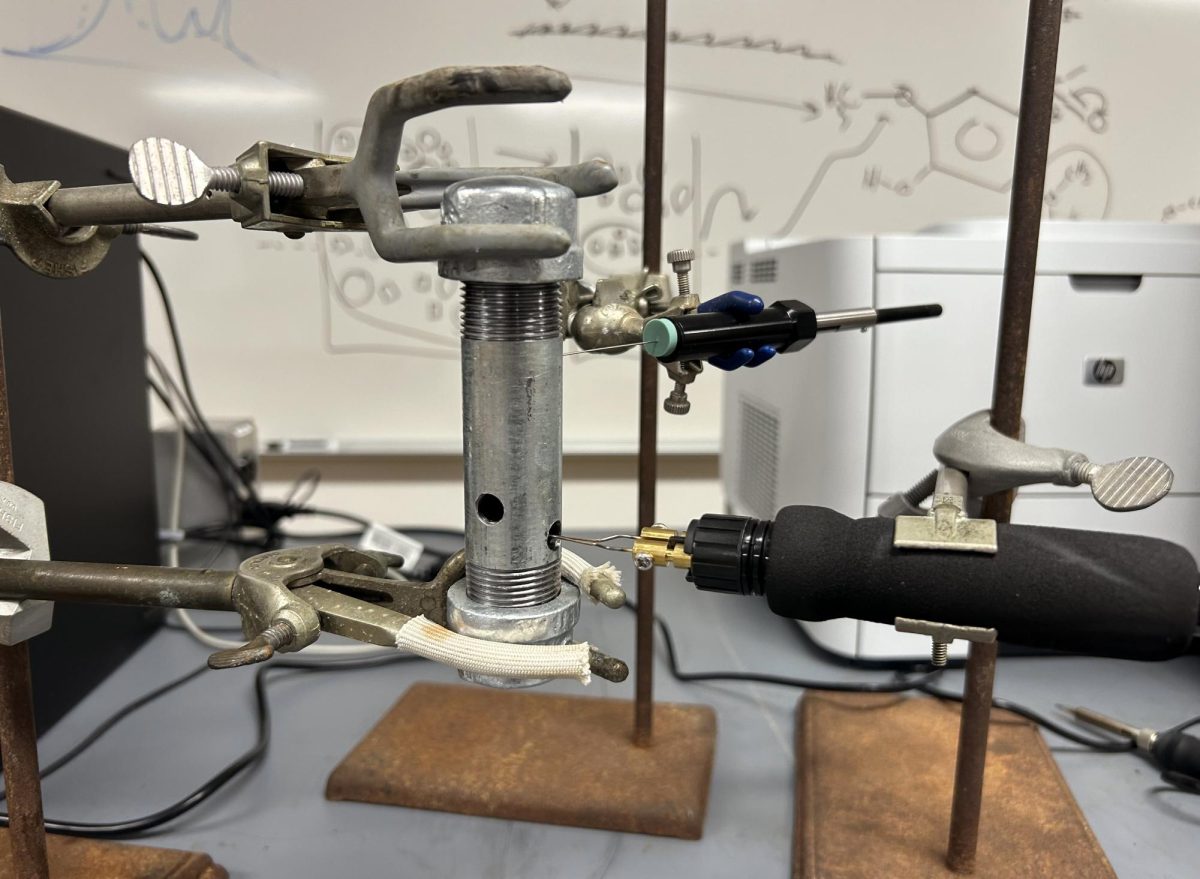Drake University’s Statement of Principles states that the University’s purpose is to transmit knowledge, pursue truth and encourage the intellectual and moral development of its students. One of the central activities contributing to this principle is research.
“Research is different from classroom work. Bridging the gap between experiences where everything works because we’ve tested it,” said Dr. Mark Vitha, Windsor Professor of Science. “We know the answer we should get. To then handle the uncertainty of, ‘I don’t know, because we’ve never done it.’ The answer isn’t always as clear.”
Project overcomes financial barriers
The Pyrolysis on Polymers STEM research project began during the Spring 2024 semester in the Chemistry Department. Using a pyrolysis chamber to burn fabrics or plastic polymers, a chromatography unit can analyze the resulting breakdown of different polymers to then read and identify what a material is made up of. Researchers and scientists can then use that breakdown to help date items for historical records or crime scene investigations.
“I worked at the Indianapolis Museum of Art for a summer, and while I was there, we used pyrolysis gas chromatography to analyze fibers from a textile,” Vitha said. “I was interested in continuing to do the work, but we don’t have a pyrolysis unit.”
A pyrolysis unit can cost about $25,000, an expense Drake cannot afford. Additionally, once mounted to the chromatography unit, the instrument would be dedicated to that technique and could no longer be used for other types of analyses.
The project intends to break down the financial barrier of chromatography research and introduce the concept into educational curricula by creating a homemade inexpensive pyrolysis chamber using plumbing material.
In an educational setting, professors need flexibility in order to teach students the different concepts of chromatography, which can include the analysis of gasoline, perfume, cologne and other semi-volatile materials.
“I was interested in the engineering aspect, building something from nothing,” said Ashlyn Hobbs, a senior student researcher. “But I was also interested in building something that is accessible for other people.”
Students choose research subject
Many different polymers have been tested and cross-referenced with existing data from other pyrolysis chambers in order to ensure that the data is plausible so that the project can be published or potentially patented for use in a lab in the future.
The research at Drake began with basic polymers that make up large amounts of different fabrics, but as the project progressed, new polymers were added to the mix.
“One thing that stands out is the freedom of it,” Hobbs said. “[Dr. Vitha said] to choose a polymer with purpose. I am interested in cars, so I wanted to use a polymer heavily used in the manufacturing of the interior of a car to see what it would look like.”
When researchers cross-reference a large number of polymers, they support that the pyrolysis chamber is accurate in a variety of identifications.
“The plastics are interesting because they are applicable to what I am interested in, which is water quality,” said Sydney Dvorak, another senior student researcher.
That flexibility and independence experienced by student researchers reflect what a lab in graduate school would be modeled after, Hobbs said.
“Vitha wants you to learn how to do that independence now to use in grad school,” Hobbs said.
Vitha said he hopes to emulate what past mentors have been to him.
“I have been the beneficiary of tremendous mentoring from a number of people,” Vitha said. “I think they were very good models of how to help students maximize their potential. I hope I provide that step in [a student’s] education.”
Students become involved in STEM research projects for a variety of reasons, from adding credits to their academic schedules to determining potential fields to enter after school.
“[The project] definitely influenced my decision to do a PhD,” Hobbs said. “There are two sides to research, experimental and theoretical, and this project made sure I enjoyed the experimental aspect and cemented that I enjoyed starting things from scratch, hands-on research and talking to a mentor.”
Vitha said that while research projects have the ability to help determine if a student wants to pursue further education, research is an important part of any Drake student’s journey, with or without future implications.
“Hands-on experience goes on everywhere, across the University, in chemistry, biochemistry, pharmacy, art history, political science,” Vitha said. “That’s what broadens each student’s educational experience.”
At the end of the Spring 2025 semester, both Hobbs and Dvorak graduate, thereby leaving the Pyrolysis on Polymers project. “I certainly don’t intend to put [the project] on the shelf. I would hope there are other students that are interested in research and chemistry,” Vitha said.







